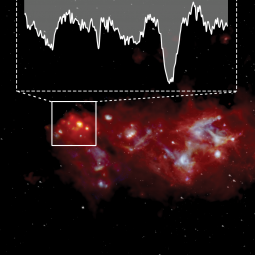By Arshia Jacob and Joan Schmelz
Paper:
First detection of
13
CH in the interstellar medium
Jacob, Arshia M., et al., 2020/08, A&A, 640A, A125.
The 12 C/ 13 C isotopic ratio has been investigated extensively because it is an important diagnostic tool for probing the nuclear history of the galaxy. Chemical evolution models predict that the ratio will increase with distance from the galactic center and decrease with time. This is because 12 C is a primary product, meaning that it results from a stellar nucleosynthesis process that can occur even in a star composed initially of pure hydrogen and helium. 13 C is a secondary product in that it forms during the carbon-nitrogen-oxygen cycle, which can occur only in stars with preexisting 12 C. Since primary nucleosynthesis can begin at an earlier epoch, an isotopic abundance ratio like 12 C/ 13 C that involves a product of both primary and secondary processes can probe the star formation history of the galaxy.
These model predictions have been confirmed by observational measurements of rotational transitions of several simple species like CO, CN, and H 2 CO and with more complex species like CH 3 CH 2 CN and CH 3 CCH. However, the trends found using different molecules show systemic variations. These are often related to isotope-selective chemical processes, which are more likely to affect the formation of the less abundant isotope. This results in 12 C/ 13 C ratios that are either higher or lower than the underlying value. In addition to these chemical effects, which do not affect every molecule in the same way, both saturation and self-absorption may skew estimates of the ratio. In an attempt to provide additional constraints, a new tracer — the methylidene radical, CH — is investigated.
Since its discovery in 1937, CH has been studied extensively because it initiates the formation of a large fraction of the C-bearing molecules in the interstellar medium. The fundamental rotational lines of CH are in the sub-mm regime and are, therefore, best observed with air- and space-borne telescopes in order to avoid atmospheric absorption.
The observed absorption spectra arise from the diffuse clouds present in spiral-arm and inter-arm regions along sightlines toward far-infrared bright, high-mass star-forming regions. Some early results with Herschel at 532/536 GHz established CH as a tracer for H 2 in diffuse clouds, but analysis of these spectra is complicated by emission features from the surrounding gas. SOFIA observes the CH transitions at 2 THz, where all the spectral features are seen in deep absorption. The analysis of these profiles is straightforward and yields reliable measurements of column density and abundance.
Observations indicate that CH and H 2 show a strong linear correlation, which make CH a promising tracer for the “CO-dark” component of the interstellar medium.
Unlike HF and OH, which are precursors to the formation of CO, CH has a distinct advantage in that its spectra are almost always optically thin and show no saturation, particularly at the velocities corresponding to the molecular clouds themselves.
While various transitions of 12 CH have been studied using a wide array of observational techniques and instruments, 13 CH had not been observed in the interstellar medium. SOFIA was able to detect, for the first time, the corresponding rotational transition of 13 CH near 2 THz towards four high-mass star-forming regions, SgrB2(M), G34.26+0.15, W51e, and W49(N).
Furthermore, because it is optically thin and relatively unaffected by isotope-selective chemical effects, CH should produce a reliable 12 C/ 13 C ratio. Therefore, the detections of 13 CH along with observations of 12 CH towards the same sources provides a new and independent diagnostic for determining the 12 C/ 13 C abundance ratio across the galaxy.
By combining the 12 C/ 13 C values derived using CH with previous measurements from different chemical species, a revised galactic gradient can be determined. The steeper slope provides new constraints on the degree of nuclear processing and galactic chemical evolution models. In addition, studies of CH will improve our understanding of interstellar chemistry. Although direct substitution of 13 C in more complex species is currently poorly understood, it could originate in simple precursors like CH.
